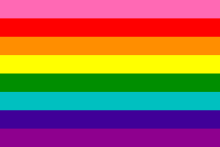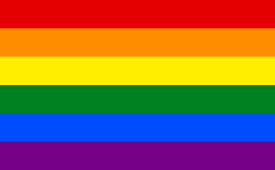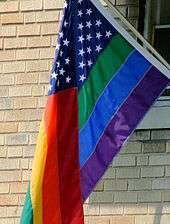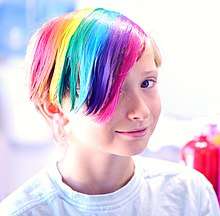Rainbow flag (LGBT movement)

| LGBT symbols |
|---|
| Flags |
| Other symbols |
The rainbow flag, commonly known as the gay pride flag or LGBT pride flag, is a symbol of lesbian, gay, bisexual and transgender (LGBT) pride and LGBT social movements. Other older uses of rainbow flags include a symbol of peace. The colors reflect the diversity of the LGBT community, as the flag is often used as a symbol of gay pride during LGBT rights marches. While this use of the rainbow flag originated in Northern California’s San Francisco Bay Area, the flag is now used worldwide.
Originally devised by San Francisco artist Gilbert Baker, the design has undergone several revisions since its debut in 1978, first to remove colors then restore them based on availability of fabrics.[1][2] The most common variant consists of six stripes: red, orange, yellow, green, blue, and violet. The flag is typically flown horizontally, with the red stripe on top, as it would be in a natural rainbow.
History


(1978–79)

Origin
Gilbert Baker, an openly gay activist born in 1951, grew up in Parsons, Kansas, and went on to serve in the US army for about two years around 1970. After an honorable discharge, Gilbert taught himself to sew. In 1974, Baker met Harvey Milk, an influential gay leader, who three years later challenged Baker to come up with a symbol of pride for the gay community.[3] The original gay pride flag flew at the San Francisco Gay Freedom Day Parade celebration on June 25, 1978. It has also been suggested that Baker may have been inspired by Judy Garland's singing "Over the Rainbow" and the Stonewall riots that happened a few days after Garland's death (she was one of the first gay icons).[4][5] Another suggestion for how the rainbow flag originated is that at college campuses during the 1960s, some people demonstrated for world peace by carrying a Flag of the Races (also called the Flag of the Human Race) with five horizontal stripes (from top to bottom they were red, white, brown, yellow, and black).[6] The first rainbow flags were commissioned by the fledgling pride committee and were produced by a team led by Baker that included artist Lynn Segerblom.[7] Segerblom was then known as Faerie Argyle Rainbow; she created the original dyeing process for the flags.[8] Baker is said to have gotten the idea for the rainbow flag from the Flag of the Races[9] in borrowing it from the Hippie movement of that time[10] largely influenced by pioneering gay activist Allen Ginsberg. The flag originally comprised eight stripes; Baker assigned specific meaning to each of the colors:[11][12][13]
| Hot pink | Sex | |
| Red | Life | |
| Orange | Healing | |
| Yellow | Sunlight | |
| Green | Nature | |
| Turquoise | Magic/Art | |
| Indigo | Serenity | |
| Violet | Spirit |
Thirty volunteers hand-dyed and stitched the first two flags for the parade.[14]
1978 to 1999
After the assassination of gay San Francisco City Supervisor Harvey Milk on November 27, 1978, demand for the rainbow flag greatly increased. To meet demand, the Paramount Flag Company began selling a version of the flag using stock rainbow fabric with seven stripes: red, orange, yellow, green, turquoise, blue, and violet. As Baker ramped up production of his version of the flag, he too dropped the hot pink stripe because of the unavailability of hot-pink fabric. Also, San Francisco-based Paramount Flag Co. began selling a surplus stock of Rainbow Girls flags from its retail store on the southwest corner of Polk and Post, at which Gilbert Baker was an employee.[15]
In 1979 the flag was modified again. When hung vertically from the lamp posts of San Francisco's Market Street, the center stripe was obscured by the post itself. Changing the flag design to one with an even number of stripes was the easiest way to rectify this, so the turquoise stripe was dropped, which resulted in a six stripe version of the flag — red, orange, yellow, green, blue, and violet.[15]
In 1989, the rainbow flag came to nationwide attention in the United States after John Stout sued his landlords and won when they attempted to prohibit him from displaying the flag from his West Hollywood, California, apartment balcony.[16]
Mile-long flags
For the 25th anniversary of the Stonewall Riots in 1994, flag creator Baker was commissioned to create the world's largest rainbow flag.[17] It took months of planning and teams of volunteers to coordinate every aspect. The flag utilized the basic six colors and measured 30 feet (9.1 m) wide. Foot-wide (0.30 m) sections of the flag were given to individual sponsors as part of a fundraiser for the Stonewall anniversary event once the event had ended. Afterwards additional large sections of the flag were sent with activists and they were used in pride parades and LGBT marches worldwide.[17] The Guinness Book of World Records confirmed it as the world's largest flag.[18]
In 2003 Baker was again commissioned to produce a giant flag. In this case it marked the 25th anniversary of the flag itself. Dubbed "25Rainbow Sea to Sea" the project entailed Baker again working with teams of volunteers but this flag utilized the original eight colors and measured one and a quarter miles (2.0 km) across Key West, Florida, from the Atlantic Ocean to the Gulf of Mexico. The flag was again cut up afterward, and sections sent to over a hundred cities worldwide.
2000s

In 2000, the University of Hawaii at Manoa changed its sports teams' name from "Rainbow Warriors" to "Warriors" and redesigned its logo to eliminate a rainbow from it. Initially Athletic Director Hugh Yoshida said that the change was to distance the school's athletic program from homosexuality. When this drew criticism, Yoshida then said the change was merely to avoid brand confusion.[19] The school then allowed each team to select its own name, leading to a mix including "Rainbow Warriors", "Warriors", "Rainbows" and "Rainbow Wahine". This decision was reversed in May 2013, when current athletic director Ben Jay reversed his earlier decision in February to force all of the men's athletic teams to be just Warriors from the patchwork of names from dropping the Rainbow Warriors name.[20]
The rainbow flag celebrated its 25th anniversary in 2003. During the gay pride celebrations in June of that year, Gilbert Baker restored the rainbow flag back to its original eight-striped version and advocated that others do the same. He later unveiled his final version with nine-stripes for the 39th anniversary of the first rainbow flag.[21] Reportedly in response to Donald Trump's election, Baker added a ninth stripe in lavender (above the hot pink stripe at the top) to represent diversity.[22][23] However, much of the wider gay community has continued to use the better known six-striped version.
In autumn 2004 several gay businesses in London were ordered by Westminster City Council to remove the rainbow flag from their premises, as its display required planning permission. When one shop applied for permission, the Planning sub-committee refused the application on the chair's casting vote (May 19, 2005), a decision condemned by gay councillors in Westminster and the then Mayor of London, Ken Livingstone. In November the council announced a reversal of policy, stating that most shops and bars would be allowed to fly the rainbow flag without planning permission.
Today some LGBT individuals and straight allies put rainbow flags in the front of their yards or front doors, or use rainbow bumper stickers on their vehicles to use as an outward symbol of their identity or support.
In June 2004 LGBT activists sailed to Australia's uninhabited Coral Sea Islands Territory and raised the rainbow flag, proclaiming the territory independent of Australia, calling it the Gay and Lesbian Kingdom of the Coral Sea Islands in protest to the Australian government's refusal to recognise same-sex marriages. The rainbow flag is the official flag of the kingdom.[24]
.jpg)
In June 2015, The Museum of Modern Art acquired the rainbow flag symbol as part of its design collection.[25][26][27]
On June 26, 2015, the White House was illuminated in the rainbow flag colors to commemorate the legalization of same-sex marriages in all 50 U.S. states, following the Obergefell v. Hodges Supreme Court decision.
Australia
On February 28, 2017, Australian Liberal Senator Eric Abetz objected to the rainbow flag being displayed in the Department of Finance[28][29] on the grounds that government departments should take a neutral stand on political debates. He concluded his comments with an incidental observation by identifying:
...[T]his particular flag is the flag of The Gay and Lesbian Kingdom of the Coral Sea Islands, which has declared war on Australia. Senator Cormann, you would understand and this is now their official flag. It is the flag of a hostile nation, if we are to believe them, having declared war on Australia...[30]
Cormann agreed, affirming that "We will make sure that there are no flags of hostile nations anywhere in any government building".
Variations

Many variations of the rainbow flag have been used. Some of the more common ones include the Greek letter lambda (lower case) in white in the middle of the flag and a pink triangle or black triangle in the upper left corner. Other colors have been added, such as a black stripe symbolizing those community members lost to AIDS. The rainbow colors have also often been used in gay alterations of national and regional flags, replacing for example the red and white stripes of the flag of the United States. In 2007, the Pride Family Flag was introduced at the Houston, Texas pride parade.
In the early years of the AIDS epidemic, AIDS activists designed a "Victory over AIDS" flag consisting of the standard six-stripe rainbow flag with a black stripe across the bottom. Leonard Matlovich, himself dying of AIDS-related illness, suggested that upon a cure for AIDS being discovered, the black stripes be removed from the flags and burned.[14]
LGBT communities in other countries have also adopted the rainbow flag. A South African gay pride flag which is a hybrid of the rainbow flag and the national flag of South Africa was launched in Cape Town in 2010. Flag designer Eugene Brockman said "I truly believe we (the LGBT community) put the dazzle into our rainbow nation and this flag is a symbol of just that."[31] On April 20, 2017, advertising agency Ogilvy & Mather announced the release of a commemorative, rainbow-colored font named "Gilbert Color", designed in collaboration with software company Fontself.[32] The font is freely distributed under a Creative Commons license.[33]
On June 8, 2017, the city of Philadelphia adopted a revised version of the flag. The design adds black and brown stripes to the top of the standard six-color flag, "to highlight black and brown LGBTQIA members within the city's community".[34] Some LGBT activists in Philadelphia and other communities criticised the flag as unnecessary and divisive.[35][36][37]
On February 12, 2018, during the street carnival of São Paulo, thousands of people attended a parade called Love Fest,[38] which celebrated human diversity, sexual and gender equality. A version of the LGBT Flag, created by Estêvão Romane, co-founder of the festival, was unveiled which presented the original 8 stripe LGBT flag with a white stripe in the middle as the 9th stripe, representing all colors (human diversity in terms of religion, gender, sex preferences, ethinicities), and peace and union among all.[39]
Rainbow colors as symbols of LGBT pride

The rainbow flag has found wide application on all manner of products. The rainbow flag colors are routinely used as a show of LGBT identity and solidarity. The rainbow colors have become so widely recognized as a symbol of LGBT pride and identity that they have effectively replaced most other LGBT symbols, including the Greek letter lambda and the pink triangle. One common item of jewelry is the pride necklace or freedom rings, consisting of six rings, one of each color, on a chain.[40][41] Other variants range from key chains to candles. In Montreal, the entrance to Beaudry metro station, which serves that city's Gay Village, was rebuilt in 1999 with rainbow-colored elements integrated into its design.[42][43]
Spirit Day
In early October 2010, Canadian teenager Brittany McMillan promoted a new LGBTQ awareness day called Spirit Day. The first observance of Spirit Day was on October 20, 2010; it now takes place on October 15.[44] On this day people wear the color purple to show support for LGBT youth who are victims of bullying.[45] Spirit Day comes from the violet stripe of the rainbow flag, which represents spirit.
See also
- GLBT Historical Society, historical society in San Francisco that houses the sewing machine used by Gilbert Baker to make the first pride flag
- LGBT symbols
- Sexuality and gender identity-based cultures
- Rainbows in culture
- Sisters of Perpetual Indulgence
- Gay and Lesbian Kingdom of the Coral Sea Islands
References
- ↑ "The Rainbow Flag". Retrieved August 21, 2007.
- ↑ Gilbert Baker (October 18, 2007). "Pride-Flyin' Flag: Rainbow-flag founder marks 30-years anniversary". Metro Weekly. Retrieved March 13, 2008.
- ↑ "MoMA Acquires the Rainbow Flag". MoMA.org. Museum of Modern Art. Retrieved May 5, 2016.
- ↑ The National Museum & Archive of Lesbian and Gay History; Lesbian and Gay Community Services Center (1996). The Gay Almanac. New York: Berkeley Books. p. 94. ISBN 978-0-425-15300-0. OCLC 636576927.
- ↑ Higgs, David (1999). Queer Sites: Gay Urban Histories Since 1600. Psychology Press. pp. 173–. ISBN 978-0-415-15897-8. Retrieved November 19, 2012 – via Google Books.
- ↑ "World Peace Association: Brotherhood flag". Crwflags.com. Retrieved 2018-06-25.
- ↑ "The woman behind the Rainbow Flag". Los Angeles Blade. March 2, 2018. Retrieved March 8, 2018.
- ↑ Hailey Branson-Potts (2018-06-08). "On the 40th anniversary of the LGBTQ pride symbol, artist wants her rainbow flag story told". Latimes.com. Retrieved 2018-06-25.
- ↑ "Symbols of Pride of the LGBTQ community". Carleton College. Archived from the original on September 7, 2008. Noted as sourced to The Alyson Almanac from the college's library.
- ↑ Goupil, Helene; Krist, Josh (2005). San Francisco: The Unknown City. Arsenal Pulp Press. p. 33. ISBN 978-1-55152-188-6.
- ↑ "San Francisco creator of gay flag shares story of strength, pride". ABC7 News. KGO-TV. March 1, 2017. Retrieved June 2, 2017.
- ↑ How the Pride Rainbow Flag Came to Be (video). NBC News. June 23, 2016. Event occurs at 2:30. Retrieved June 2, 2017 – via YouTube.
It's a flag, it needed to have depth, and so I liked the idea that each color would represent an element of everyone's life.
- ↑ Gilbert Baker: The Gay Betsy Ross (video). In the Life Media. June 23, 2016. Event occurs at 2:31. Retrieved June 2, 2017 – via YouTube.
- 1 2 Witt, Lynn; Thomas, Sherry; Marcus, Eric, eds. (1995). Out in All Directions: A Treasury of Gay and Lesbian America. New York: Warner Books. p. 435. ISBN 978-0-446-67237-5. OCLC 37034700.
- 1 2 "Unsung Heroes of the Gay World: Vexillographer Gilbert Baker: The Gay Betsy Ross". UK Gay News. April 17, 2008. Archived from the original on July 21, 2009. Retrieved September 23, 2009.
- ↑ Russell, Ron (December 8, 1988). "Removal of 'Gay Pride' Flag Ordered: Tenant Suit Accuses Apartment Owner of Bias". Los Angeles Times. Part 9, 6.
- 1 2 San Francisco Neighborhoods: The Castro (Documentary). KQED-TV.
- ↑ Young, Mark C. (October 1, 1994). The Guinness book of records. Facts on File. pp. 307–. ISBN 9780816026463. Retrieved November 19, 2012.
- ↑ Whitley, David (August 9, 2008). "More buzz over 'Bows". Orlando Sentinel. Retrieved December 17, 2008.
- ↑ Dave Reardon; Brian McInnis (May 14, 2013). "All UH men's teams will be named Rainbow Warriors". Honolulu Star Advertiser. Retrieved June 4, 2013.
- ↑ "Gilbert Baker, Gay Activist Who Created the Rainbow Flag, Dies at 65". Retrieved 2018-07-23.
- ↑ Wong, Curtis M. (2018-06-07). "The History And Meaning Of The Rainbow Pride Flag". Huffington Post. Retrieved 2018-07-23.
- ↑ "Flags | Gillbert Baker". gilbertbaker.com. Retrieved 2018-07-23.
- ↑ "Introduction". Gay and Lesbian Kingdom of the Coral Sea Islands. Archived from the original on July 10, 2007.
- ↑ Lowder, J. Bryan (June 18, 2015). "MoMA Preserves Pride by Acquiring the Rainbow Flag". Slate. Retrieved June 24, 2015.
- ↑ Antonelli, Paola; Fisher, Michelle Millar (June 17, 2015). "MoMA Acquires the Rainbow Flag". Museum of Modern Art. Retrieved June 24, 2015.
- ↑ Martinez, Alanna (June 17, 2015). "The Rainbow Flag Joins the Museum of Modern Art's Collection". Observer. Retrieved June 24, 2015.
- ↑ Matt Young (February 28, 2017). "Conservative Liberal Senator Eric Abetz has an issue with the rainbow flag, comparing it to a 'hostile nation'". news.com.au.
- ↑ Jones, Jess (February 28, 2017). "Senator Eric Abetz criticises government department flying 'hostile' activist rainbow flag". Star Observer.
- ↑ "Finance and Public Administration Legislation Committee - 28/02/2017 - Estimates - FINANCE PORTFOLIO - Department of Finance". Hansard. February 28, 2017. p. 27.
- ↑ "South African Flag Revealed at MCQP". Cape Town Pride. December 22, 2010. Archived from the original on August 9, 2011. Retrieved April 4, 2011.
- ↑ @Ogilvy (April 20, 2017). "In memory of Gilbert Baker, creator of the Rainbow Flag, we've created a font for all" (Tweet) – via Twitter.
- ↑ "FAQs". TypeWithPride.com. Retrieved June 9, 2017.
- ↑ Owens, Ernest. "Philly's Pride Flag to Get Two New Stripes: Black and Brown". Philadelphia. Metro Corp. Retrieved June 10, 2017.
- ↑ "New pride flag divides Philly's gay community". New York Post. June 16, 2017. Retrieved June 18, 2017.
- ↑ "Controversy Flies Over Philadelphia's New Pride Flag". NBC News. June 15, 2017. Retrieved June 18, 2017.
- ↑ Mynameisjosephine (June 15, 2017). "Black Activists Add Black & Brown to Pride Rainbow Flag". Retrieved June 18, 2017 – via Facebook.
- ↑ Love Fest inunda o Centro de música baiana e amor à população LGBT
- ↑ Love Fest promove luta contra homofobia no Carnaval de SP
- ↑ Gage, Simon; Richards, Lisa; Wilmot, Simon Gage Lisa Richards Howard; Boy George (June 13, 2002). Queer. Da Capo Press. pp. 50–. ISBN 9781560253778. Retrieved November 19, 2012.
- ↑ Schmidt, Kathryn J. (2008). Lesbian Identity Management in Workplace Contexts: "Don't Ask, Don't Tell" in Mainstream Organizations. ProQuest. pp. 96–. ISBN 9780549535461. Retrieved November 19, 2012.
- ↑ Hinrichs, Donald W. (January 4, 2012). Montreal's Gay Village: The Story of a Unique Urban Neighborhood Through the Sociological Lens. iUniverse. pp. 40–. ISBN 9781462068371. Retrieved November 19, 2012.
- ↑ Fodor's (February 5, 2008). Fodor's Montreal and Quebec City 2008. Random House Digital, Inc. pp. 48–. ISBN 9781400018994. Retrieved November 19, 2012.
- ↑ "Go purple on October 15, 2015 for #spiritday". GLAAD. Retrieved June 30, 2015.
- ↑ Wackrow, Kyle (October 10, 2010). "Spirit Day to honor recent homosexual suicide victims". The Eastern Echo. Archived from the original on October 17, 2010. Retrieved October 26, 2010.
External links
| Wikimedia Commons has media related to LGBT pride flags. |
- "Unsung Heroes of the Gay World: Vexillographer Gilbert Baker". UK Gay News. April 17, 2008. Archived from the original on August 25, 2016.